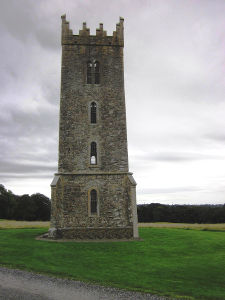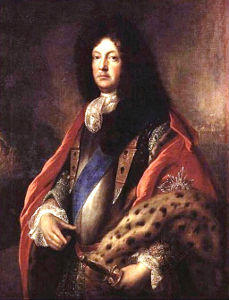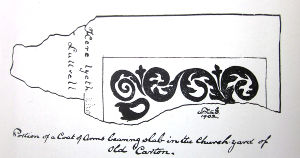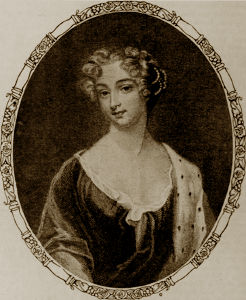Tyrconnell Tower
A picturesque tower on the summit of a hill overlooking
Carton House, Maynooth
Published in Maynooth Newsletter, November, 2014
The Tyrconnell Tower in Carton Demesne stands on the summit of a hill dominating the present Carton House Golf Club. It is an eye-catching feature throughout a substantial area of north Kildare and south Meath named after Richard Talbot the duke of Tyrconnell who was the viceroy between 1687 and 1689. Tyrconnell was born in Carton House and was a member of the Talbot family who held the estate throughout the 17th century.1
The tower is one of three sites or locations in the locality that has the Tyrconnell name. The others include a bedroom suite in Barberstown Castle named the ‘Lady Tyrconnell’, and a plaque on the gable wall of Rathcoffey Church commemorating Lady Tyrconnell’s connection to the church.2
Date of Erection
The Tyrconnell Tower predates the FitzGerald building programme at Carton which began with the remodeling of the house and the development of the estate by Robert 19th Earl of Kildare in the 1739. It is known that no building work was carried out on the estate between 1689 when Tyrconnell was the owner and 1739. This clearly points to the Tyrconnell-Talbot family ownership of Carton and a date in the late 17th century for the erection of the Tower. Other evidence that suggests a 17th century construction comes from an engraving of Carton dating from the early 1700s which show the original Talbot House and estate at Carton. This image was published by Lord Walter FitzGerald in the Kildare Archaeological Journal in 1902 and clearly shows the Tyrconnell Tower. Lord Walter examined the engraving and concluded that the tower appeared to be a ruin at that stage.3
Follys
A suggestion that it was originally built as a folly can be discounted as it predates the era of follys. The follys at Larchill and Dangan for instance date from the 1730s; the Connolly Folly or the Obelisk close to Carton from 1740 and the Aylmer Folly on the Hill of Allen dates from the 1860s.4 However, it is known that Augustine Frederick 3rd Duke of Leinster restored the tower as a folly in the early 19th century. It was as a folly that the duke brought Queen Victoria to view the tower when she visited Carton in 1849.5 From the tower the Queen could see many of the great wooded estates in Kildare and Meath which added to the pleasant scenery of the locality. From the tower today the park like landscape of the two counties are still evident.
Tyrconnell-Talbot family
The construction of the tower evidently belongs to the Tyrconnell-Talbot family and exploring its early history requires a study of the Talbot family. The duke of Tyrconnell’s father, Sir William Talbot of Malahide acquired the leasehold of Carton Estate in 1603. The estate did not have the same area as the present Carton Estate, the principal dwelling was Old Carton Castle which had a chapel of ease within the grounds of the castle. The site of this castle is in the farm-yard of ‘Leinster Stud’ and the site of the chapel is in Old Carton graveyard, situated on the Dunboyne road half a mile east from the Dunboyne entrance to Carton.
William Talbot was as a man of important status and having acquired Carton Estate he set out to increase his standing locally and establish strong roots for himself and his family in his adopted area. This required a number of tasks; firstly, to build an impressive seat; secondly, to establish a local family burial plot and thirdly, an involvement in local affairs. He was quiet successful in both local and national affairs serving as an MP for county Kildare and was regarded as one of the leaders of the Old English Party in the Irish parliament. In 1623, King James I, granted him the title of Sir William Talbot 1st Baronet of Carton.6
The castle at Old Carton may have been a secure residence in the medieval period but by the 17th century it would have been unsuitable as a fashionable residence. The new residence may have been built shortly after William Talbot’s marriage in 1607. It was a substantial dwelling on the site of the present Carton house. Much of the original Carton House was incorporated within the present structure when the house was remodeled and extended in 1739 by Robert 19th Earl of Kildare.7
Sir William Talbot and his wife Alison had sixteen children, eight sons and eight daughters. The second son was Peter Talbot, a famous Archbishop of Dublin, and the eighth was Richard Talbot, duke of Tyrconnell the man who gave the Tower its name.
William Talbot died on the 16th of March 1633. Some confusion exists at to where he was buried with one source indicating it was in Laraghbryan Cemetery and another suggesting Old Carton Graveyard. Local tradition suggests it was Old Carton where Sir William and his wife Alison were buried, this was also confirmed by research carried out by Lord Walter FitzGerald.8 He would have been buried in a vault in the chapel or a mortuary wing of the chapel at Old Carton. The outline of this is chapel is still visible in Old Carton graveyard. Other members of the family were buried in the family vault throughout the 17th century.
Richard Duke of Tyrconnell
By the 1680s Richard Talbot, William’s youngest son had acquired Carton Estate. He had served the Stuart Kings throughout most of his life and returned to Carton in 1685 when King James II appointed him commander in chief of the army. He was also granted a title Baron of Talbotstown and subsequently an additional title of Earl of Tyrconnell. His first wife had died in 1679 and he subsequently married the glamorous Frances Jennings, one of the most beautiful women of her day. Other positions and titles were granted to Tyrconnell. James II appointed him Viceroy of Ireland in 1687 and he was also elevated to the title Duke of Tyrconnell. In the late 1680s he was the most powerful man in the country and ruled it in the name of King James II. During this period, he renamed Carton ‘Talbotstown’ after his family name and title and the house functioned more like a palace than a country house.9 The Viceregal Lodge at the time was in Chapleizord and Tyrconnell used Talbotstown [Carton] for important functions. He had a glamorous lifestyle, a wife renowned for her beauty, and on the estate a chapel and a family burial plot almost certainly sited in the chapel. Other families in the area not as powerful as the Tyrconnells had family mausoleums adjoining churches close to their residence. Relevant examples include, the Aylmers of Donadea and the Dongons of Castletown. Tyrconnell’s sister Mary Talbot was the wife of Sir John Dongon and she herself was buried in an impressive mausoleum adjoining the Church at Tea Lane, graveyard in Celbridge. By all accounts the Talbot burial chamber may not have been as impressive as the burial chambers of neighbouring members of the aristocracy and this may have motivated Tyrconnell to construct an elaborate mausoleum on the summit of the hill at Carton to replace what may have been a modest burial chamber at Old Carton.
Construction of the Tyrconnell Tower
Stonework over the entrance to the Tyrconnell Tower reveals a high arched feature which could suggest that the original ground floor may been a vaulted structure. One of the best examples in the area of a mausoleum from this period is the Maunsell mausoleum in Tea Lane, Graveyard Celbridge. It was originally the Dongan mausoleum and the ground floor area is vaulted. Lord Walter FitzGerald suggests that the high arched entrance in the Tyrconnell Tower may have been to facilitate adding a wing onto the building and that the original plans may not have been completed. This suggestion indicates that a wing, possibly a small chapel, may have been intended to be added to the structure. The tower following its construction was known as ‘The Steeple’. The term which comes from an estate map of Carton in 1739 showing a field known as the Steeple field where the tower is located gives ample proof of an ecclesiastical purpose for the Tower.10 The likelihood is that Tyrconnell built the tower as the family mausoleum for himself and his wife and it would be his intention to remove the remains of his parents and other family members and monuments to their memory from the burial chamber at Old Carton to the new mausoleum.
Some scant details of the Talbot family memorial in Old Carton survives with one mentioned in the OS letters from October 1837. Only the lid or side piece survived which was described as ornamented with carvings and figures of animals. The local tradition at the time was adamant that the slab belonged to the Talbot family. Two generations later in 1902, Lord Walter FitzGerald found the remains of the burial monument but by that time it had deteriorated and was greatly reduced in size. Unfortunately no carvings of animals or any markings that would give clues of which family crest that may have been on it survived. Furthermore, there were no details to suggest a connection to the Tyrconnell-Talbot family. The slab measured five and a half feet in length and from nine inches to two feet in breadth. It was three inches in thickness and the edges were mitred. The writing detail was so deteriorated that Lord Walter could only give an approximate presumption which was as follows: on the first line ‘Here Lyeth’ and on the second line only one word which looked like ‘Luttrell’. This puzzled Lord Walter as he knew the family background of the Talbots, and there was no Luttrell connection to the family.11 Investigation for the present study, however, revealed that the doubtful family name may in fact Netterville. When erosion of grave stones has taken place names with similar lettering, such as Luttrell and Netterville can become indistinguishable and this may be the case here. An examination of genealogical records show that Sir William Talbot’s wife was Alison Netterville. In gravestones and burial slabs from this period the maiden name of the Lady of the household was always included. In addition the coat of arms of both the head of the household and his wife were likewise incorporated.
Conclusion
In conclusion it appears that Tyrconnell was in the process of building a mausoleum for himself and his family when the Jacobite-Williamite War occurred. In all probability it was his intention to re-intern his immediate Talbot relatives in the new mausoleum had the Tower been fully completed. When the Williamites occupied the Maynooth area in late July 1690 it is reputed that they seized personal items and property belonging to Jacobite leaders such as Tyrconnell. Tyrconnell’s property was excluded in the provisions of the Treaty of Limerick which guaranteed that no landholder would forfeit their estates. It is likely that the Talbot burial monument was broken in this period while the war was taking place or shortly afterwards.
Tyrconnell died of apoplexy in Limerick in 1691 during the second siege of the city and was buried there in St. Mary’s Cathedral. During the siege the Cathedral was badly damaged. However, in the aftermath of the war William of Orange granted £1,000 towards its restoration. It is ironic that although Williamite supporters in the Maynooth area were blamed for the destruction of Jacobite property which may have included the Talbot burial monument, William of Orange financially supported the restoration of a Cathedral where Tyrconnell is buried. Tyrconnell’s widow was also buried in a Cathedral. She died in 1730 and was buried in the Jones’s family vault of St. Patrick’s Cathedral, Dublin.12 Had history been different both the duke and duchess of Tyrconnell could be resting together in a vault in the Tyrconnell Tower.
Footnotes
- Lord Walter FitzGerald, ‘Carton’ in Journal of Kildare Archaeological Society, Vol. IV, p. 8.
- Tony McEvoy, ‘Clane and Rathcoffey Parish, 1972–2010’, in A History of Christianity in Clane and Rathcoffey (Clane, 2011), p. 206.
- FitzGerald, Carton, p. 24.
- A date stone of 1859 is carved over the entrance to the Aylmer Tower at Allen. This represents the date when construction of the tower commenced. The structure took four years to build.
- Freeman’s Journal, 11 August 1849.
- FitzGerald, Carton, p. 5.
- FitzGerald, Carton, pp 12, 14.
- FitzGerald, Carton, p. 6.
- For details of the Tyrconnells see Philip P. Sergeant, Little Jennings and Fighting Dick Talbot: A life of the Duke and Duchess of Tyrconnell (London, 1913).
- FitzGerald, Carton, p. 25.
- FitzGerald, Carton, pp 30, 32.
- Seamus Cullen, ‘Establishing Rathcoffey Church in 1710’, in A History of Christianity in Clane & Rathcoffey, pp. 62–63.




